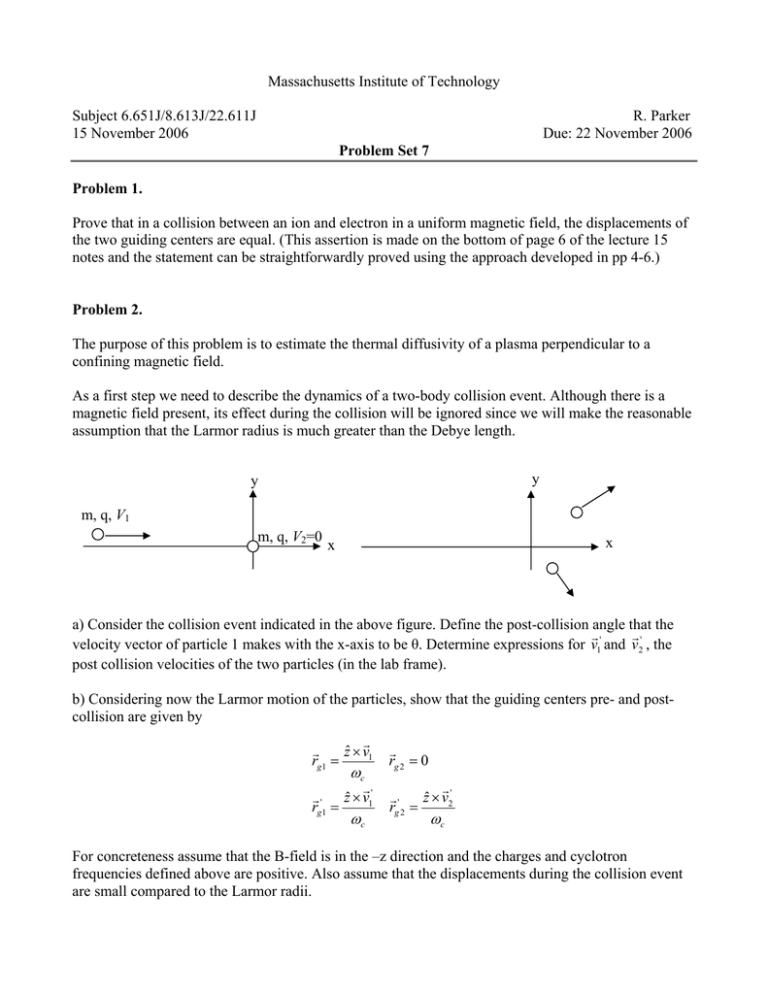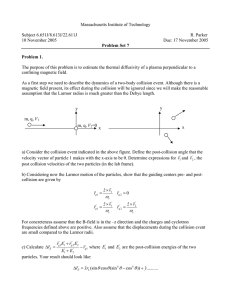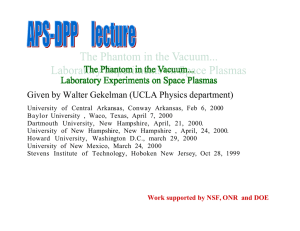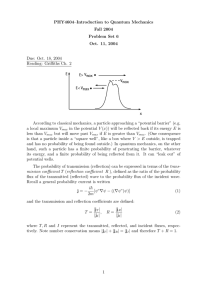Massachusetts Institute of Technology Subject 6.651J/8.613J/22.611J R. Parker
advertisement

Massachusetts Institute of Technology Subject 6.651J/8.613J/22.611J 15 November 2006 R. Parker Due: 22 November 2006 Problem Set 7 Problem 1. Prove that in a collision between an ion and electron in a uniform magnetic field, the displacements of the two guiding centers are equal. (This assertion is made on the bottom of page 6 of the lecture 15 notes and the statement can be straightforwardly proved using the approach developed in pp 4-6.) Problem 2. The purpose of this problem is to estimate the thermal diffusivity of a plasma perpendicular to a confining magnetic field. As a first step we need to describe the dynamics of a two-body collision event. Although there is a magnetic field present, its effect during the collision will be ignored since we will make the reasonable assumption that the Larmor radius is much greater than the Debye length. y y m, q, V1 m, q, V2=0 x x a) Consider the collision event indicated in the above figure. Define the post-collision angle that the r r velocity vector of particle 1 makes with the x-axis to be θ. Determine expressions for v1' and v2' , the post collision velocities of the two particles (in the lab frame). b) Considering now the Larmor motion of the particles, show that the guiding centers pre- and postcollision are given by r r zˆ × v1 rg1 = r rg 2 = 0 r r zˆ × v1' rg'1 = r r zˆ × v2' rg' 2 = ωc ωc ωc For concreteness assume that the B-field is in the –z direction and the charges and cyclotron frequencies defined above are positive. Also assume that the displacements during the collision event are small compared to the Larmor radii. r' ' r' ' r rg1 E1 + rg 2 E2 r − rg1 where E1' and E2' are the post-collision energies of the two c) Calculate ΔrE = ' ' E1 + E2 particles. Your result should look like: r ΔrE = xˆrL (sin θ cos θ (sin 4 θ − cos 4 θ )) + yˆ .......... d) Estimate χ by the relation χ~ ∞ r d r2 ΔrE ~ nVth ∫ ΔrE2 (V1 = Vth )2πbdb dt 0 Evaluate the integral only to order ln Λ . (Hint: Express sinθ and cosθ in terms of b.) Which is dominant, ion or electron thermal diffusivity across the field? Problem 3. The figure below shows a plane wave normally incident on a plasma slab. The plasma has a dielectric ω p2 constant given by ε = ε 0 (1 − 2 ) . ω H E k a) Calculate the reflection coefficient Γ defined by Γ= E ref E inc where E inc and E ref are the complex amplitudes of the electric field of the incident and reflected wave. For what frequencies is the incident power totally reflected? Evaluate numerically for a density of 1012/m3 , typical of the maximum density in the ionosphere. Note: For those not familiar with this type of problem, assume an incident, transmitted and reflected wave, and match the tangential components of E and H across the slab interface. Solve for the reflected electric field amplitude in terms of the amplitude of the incident wave. Problem 3 (Continued) When an EM wave is radiated vertically toward the ionosphere, it propagates through a region of increasing plasma density (and dielectric constant). If the frequency matches the local plasma frequency at some point, it will be reflected. This part of the problem develops the treatment of the propagation of such a wave. b) Consider a transverse EM wave propagating vertically through the ionosphere. Take the vertical direction to coincide with the z axis and assume that the wave is polarized in the x-direction so that E = xˆ E ( z ) exp(−iωt ). Show that the equation for E (z ) can be written in the form: d 2E + k 2 ( z)E = 0 dz 2 (1) ⎛ ω p2 ( z ) ⎞ ⎟ and k 0 = ω is the free space wave-number. (Neglect the effect of the where k 2 = k02 ⎜1 − 2 ⎟ ⎜ ω ⎠ c ⎝ Earth's magnetic field on the plasma dielectric constant.) c) Assume that ω = ω p at z = 0 and that in the neighborhood of z = 0 the density is adequately modeled as having a linear dependence on z, i.e., n( z ) ≈ n( z = 0)(1 + z / a) where a is the density scale n( z = 0) . Find the general solution for E (z ) . length, a = dn / dz z=0 d 2w − zw = 0 is aAi( z ) + bBi( z ) where a and b dz 2 are constants and Ai and Bi are Airy functions (see e.g., M. Abramowitz and I. Stegun, Handbook of Mathematical Functions). For large positive z, the function Ai decays exponentially while the function Bi grows exponentially. Hint: The general solution of the differential equation d) Away from z = 0, the solution for the electric field for z < 0 is well represented by the WKB form E = E+ 1 1 exp(i ∫ k ( z ' )dz ' ) +E− 1 2 exp(−i ∫ k ( z ' )dz ' ) 12 k k From your result in part c), determine the reflection coefficient Γ = Hint: For large negative z, Ai → 1 π12 z 14 E− . E+ 1 ⎛2 32 π ⎞ ⎛2 32 π ⎞ sin ⎜ z + ⎟, Bi → 1 2 1 4 cos⎜ z + ⎟ . 4⎠ 4⎠ ⎝3 ⎝3 π z





